Report: Change from Paper-Based to Computer-Based Documentation
VerifiedAdded on 2022/09/23
|8
|2073
|21
Report
AI Summary
This report comprehensively examines the transition from paper-based to computer-based clinical documentation in healthcare settings, addressing the need for quality improvement. It begins with an overview of the shift and its benefits, emphasizing the importance of accurate, timely, and legible data for effective patient care and organizational efficiency. The report then explains Lewin's change management model, detailing the stages of unfreezing, change, and refreezing, and how each relates to the implementation process. The core of the report analyzes factors influencing the implementation of computer-based documentation, including staff experiencing reality shock, organizational culture, employer expectations for continuous quality improvement, managing interpersonal relationships and stress, and addressing unhealthy work environments. Key challenges such as inadequate training, implementation time, insufficient testing, lack of resources, and poor communication are discussed, along with potential solutions. The report concludes by emphasizing the importance of teamwork, addressing challenges, and acknowledging the successes achieved during the transition. The provided bibliography offers a list of all the references used in this report.
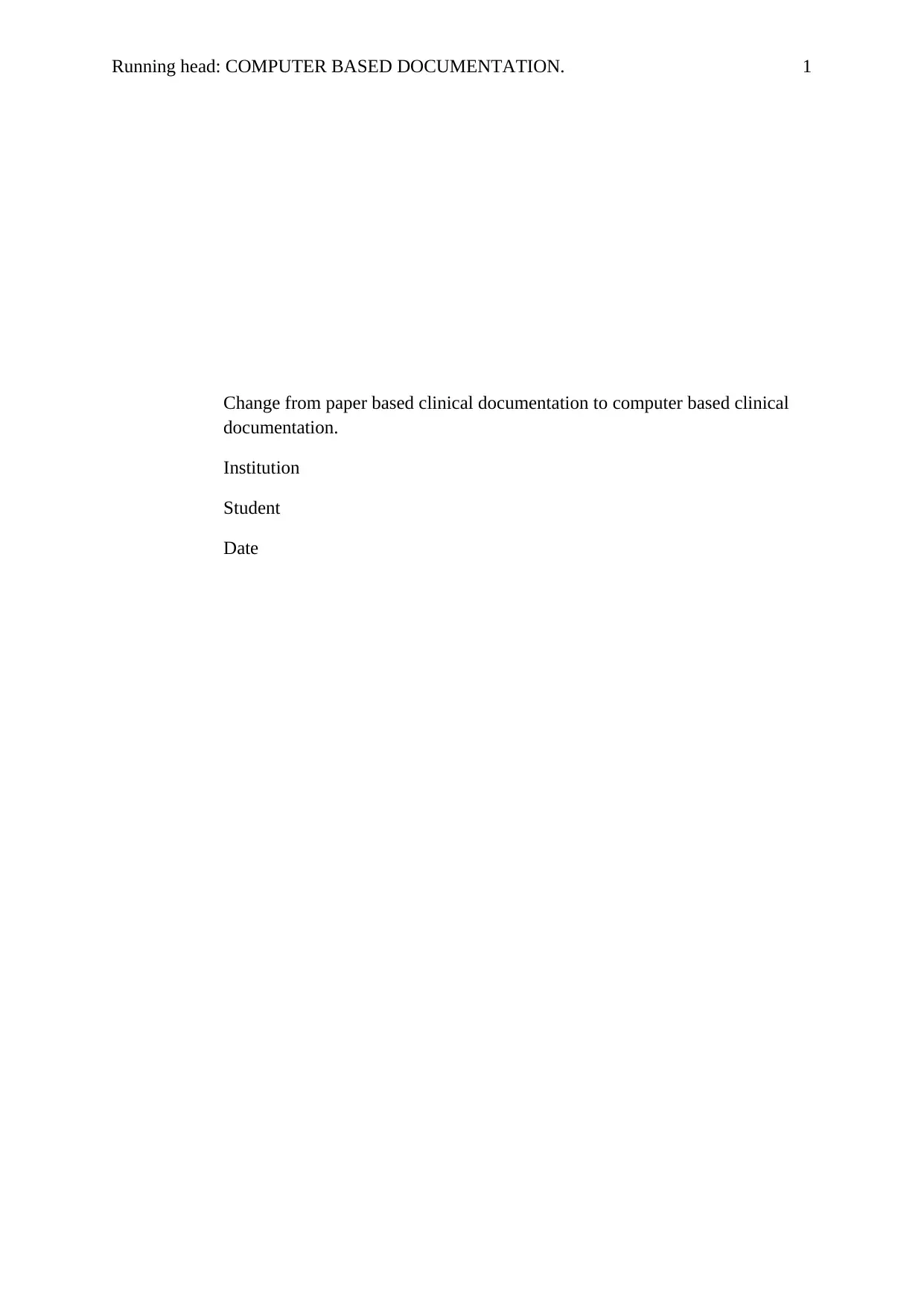
Running head: COMPUTER BASED DOCUMENTATION. 1
Change from paper based clinical documentation to computer based clinical
documentation.
Institution
Student
Date
Change from paper based clinical documentation to computer based clinical
documentation.
Institution
Student
Date
Paraphrase This Document
Need a fresh take? Get an instant paraphrase of this document with our AI Paraphraser
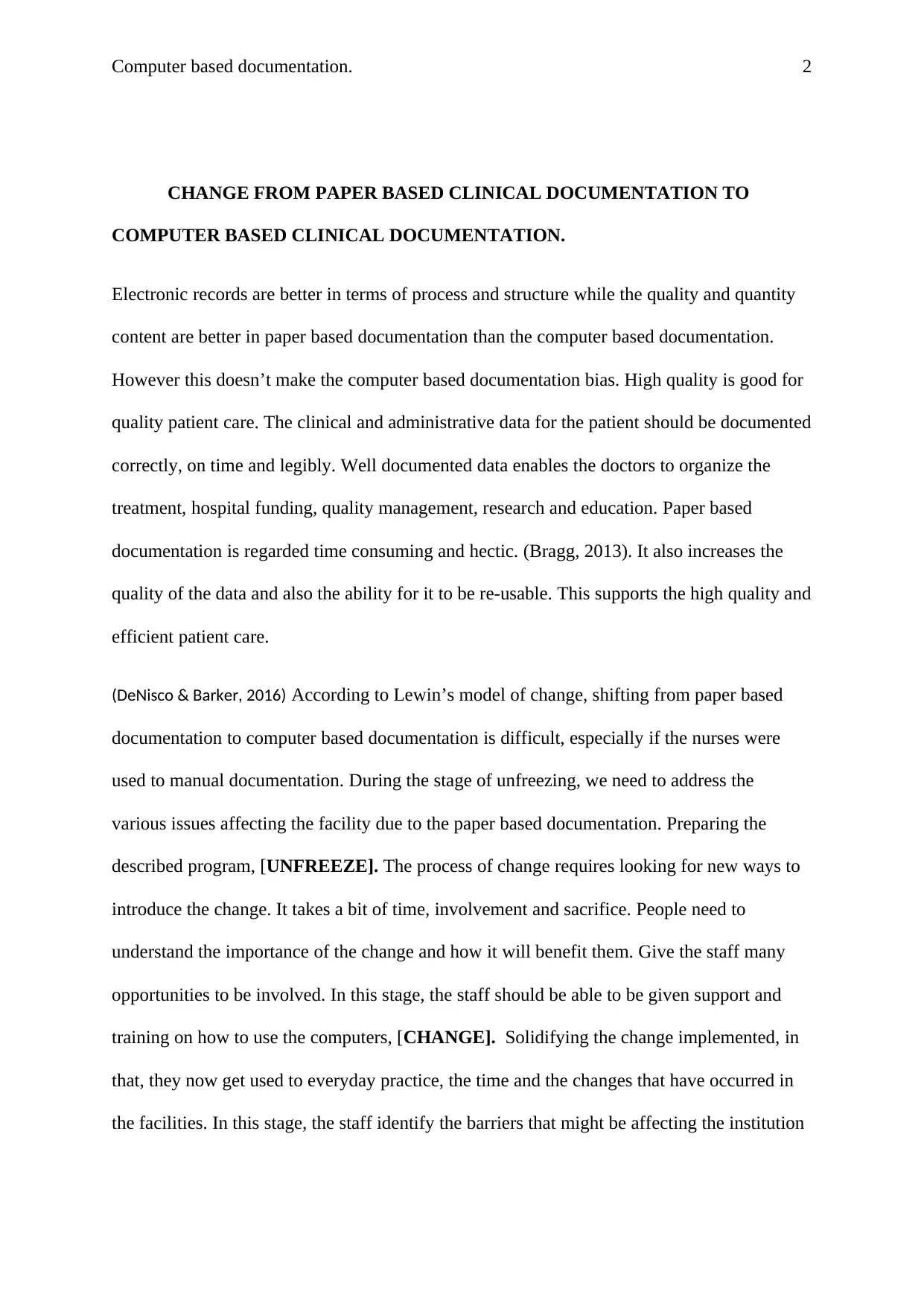
Computer based documentation. 2
CHANGE FROM PAPER BASED CLINICAL DOCUMENTATION TO
COMPUTER BASED CLINICAL DOCUMENTATION.
Electronic records are better in terms of process and structure while the quality and quantity
content are better in paper based documentation than the computer based documentation.
However this doesn’t make the computer based documentation bias. High quality is good for
quality patient care. The clinical and administrative data for the patient should be documented
correctly, on time and legibly. Well documented data enables the doctors to organize the
treatment, hospital funding, quality management, research and education. Paper based
documentation is regarded time consuming and hectic. (Bragg, 2013). It also increases the
quality of the data and also the ability for it to be re-usable. This supports the high quality and
efficient patient care.
(DeNisco & Barker, 2016) According to Lewin’s model of change, shifting from paper based
documentation to computer based documentation is difficult, especially if the nurses were
used to manual documentation. During the stage of unfreezing, we need to address the
various issues affecting the facility due to the paper based documentation. Preparing the
described program, [UNFREEZE]. The process of change requires looking for new ways to
introduce the change. It takes a bit of time, involvement and sacrifice. People need to
understand the importance of the change and how it will benefit them. Give the staff many
opportunities to be involved. In this stage, the staff should be able to be given support and
training on how to use the computers, [CHANGE]. Solidifying the change implemented, in
that, they now get used to everyday practice, the time and the changes that have occurred in
the facilities. In this stage, the staff identify the barriers that might be affecting the institution
CHANGE FROM PAPER BASED CLINICAL DOCUMENTATION TO
COMPUTER BASED CLINICAL DOCUMENTATION.
Electronic records are better in terms of process and structure while the quality and quantity
content are better in paper based documentation than the computer based documentation.
However this doesn’t make the computer based documentation bias. High quality is good for
quality patient care. The clinical and administrative data for the patient should be documented
correctly, on time and legibly. Well documented data enables the doctors to organize the
treatment, hospital funding, quality management, research and education. Paper based
documentation is regarded time consuming and hectic. (Bragg, 2013). It also increases the
quality of the data and also the ability for it to be re-usable. This supports the high quality and
efficient patient care.
(DeNisco & Barker, 2016) According to Lewin’s model of change, shifting from paper based
documentation to computer based documentation is difficult, especially if the nurses were
used to manual documentation. During the stage of unfreezing, we need to address the
various issues affecting the facility due to the paper based documentation. Preparing the
described program, [UNFREEZE]. The process of change requires looking for new ways to
introduce the change. It takes a bit of time, involvement and sacrifice. People need to
understand the importance of the change and how it will benefit them. Give the staff many
opportunities to be involved. In this stage, the staff should be able to be given support and
training on how to use the computers, [CHANGE]. Solidifying the change implemented, in
that, they now get used to everyday practice, the time and the changes that have occurred in
the facilities. In this stage, the staff identify the barriers that might be affecting the institution
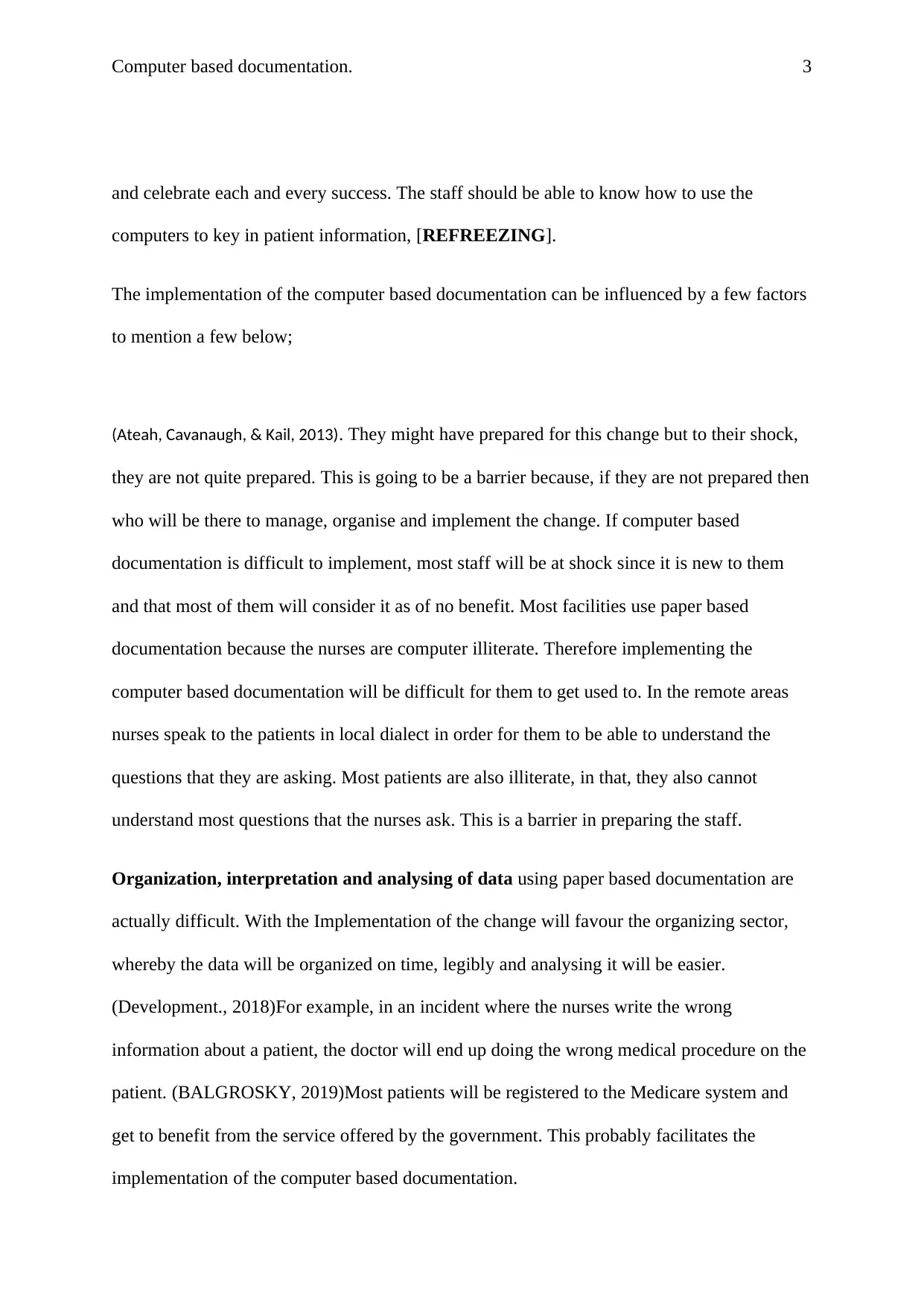
Computer based documentation. 3
and celebrate each and every success. The staff should be able to know how to use the
computers to key in patient information, [REFREEZING].
The implementation of the computer based documentation can be influenced by a few factors
to mention a few below;
(Ateah, Cavanaugh, & Kail, 2013). They might have prepared for this change but to their shock,
they are not quite prepared. This is going to be a barrier because, if they are not prepared then
who will be there to manage, organise and implement the change. If computer based
documentation is difficult to implement, most staff will be at shock since it is new to them
and that most of them will consider it as of no benefit. Most facilities use paper based
documentation because the nurses are computer illiterate. Therefore implementing the
computer based documentation will be difficult for them to get used to. In the remote areas
nurses speak to the patients in local dialect in order for them to be able to understand the
questions that they are asking. Most patients are also illiterate, in that, they also cannot
understand most questions that the nurses ask. This is a barrier in preparing the staff.
Organization, interpretation and analysing of data using paper based documentation are
actually difficult. With the Implementation of the change will favour the organizing sector,
whereby the data will be organized on time, legibly and analysing it will be easier.
(Development., 2018)For example, in an incident where the nurses write the wrong
information about a patient, the doctor will end up doing the wrong medical procedure on the
patient. (BALGROSKY, 2019)Most patients will be registered to the Medicare system and
get to benefit from the service offered by the government. This probably facilitates the
implementation of the computer based documentation.
and celebrate each and every success. The staff should be able to know how to use the
computers to key in patient information, [REFREEZING].
The implementation of the computer based documentation can be influenced by a few factors
to mention a few below;
(Ateah, Cavanaugh, & Kail, 2013). They might have prepared for this change but to their shock,
they are not quite prepared. This is going to be a barrier because, if they are not prepared then
who will be there to manage, organise and implement the change. If computer based
documentation is difficult to implement, most staff will be at shock since it is new to them
and that most of them will consider it as of no benefit. Most facilities use paper based
documentation because the nurses are computer illiterate. Therefore implementing the
computer based documentation will be difficult for them to get used to. In the remote areas
nurses speak to the patients in local dialect in order for them to be able to understand the
questions that they are asking. Most patients are also illiterate, in that, they also cannot
understand most questions that the nurses ask. This is a barrier in preparing the staff.
Organization, interpretation and analysing of data using paper based documentation are
actually difficult. With the Implementation of the change will favour the organizing sector,
whereby the data will be organized on time, legibly and analysing it will be easier.
(Development., 2018)For example, in an incident where the nurses write the wrong
information about a patient, the doctor will end up doing the wrong medical procedure on the
patient. (BALGROSKY, 2019)Most patients will be registered to the Medicare system and
get to benefit from the service offered by the government. This probably facilitates the
implementation of the computer based documentation.
⊘ This is a preview!⊘
Do you want full access?
Subscribe today to unlock all pages.

Trusted by 1+ million students worldwide
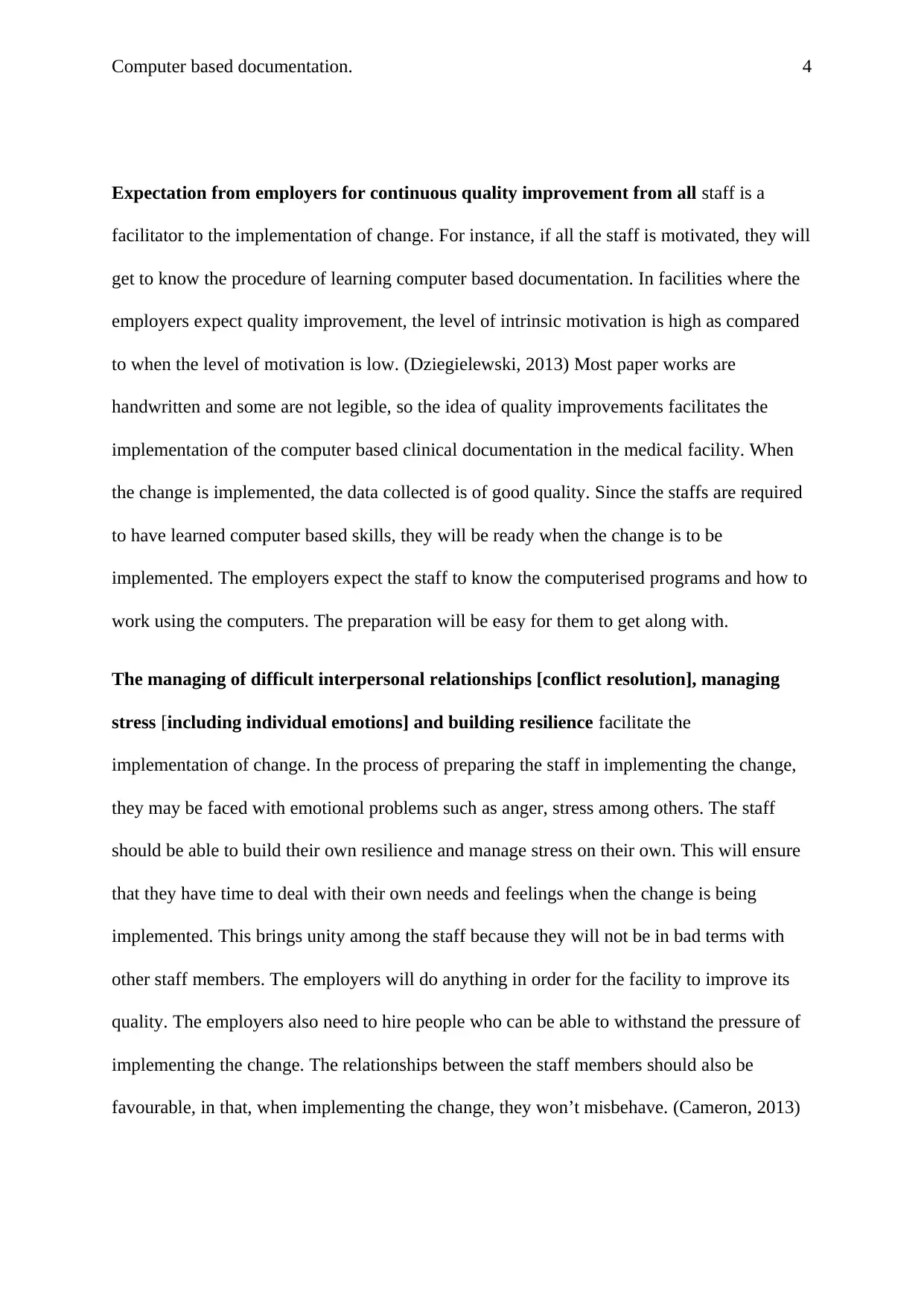
Computer based documentation. 4
Expectation from employers for continuous quality improvement from all staff is a
facilitator to the implementation of change. For instance, if all the staff is motivated, they will
get to know the procedure of learning computer based documentation. In facilities where the
employers expect quality improvement, the level of intrinsic motivation is high as compared
to when the level of motivation is low. (Dziegielewski, 2013) Most paper works are
handwritten and some are not legible, so the idea of quality improvements facilitates the
implementation of the computer based clinical documentation in the medical facility. When
the change is implemented, the data collected is of good quality. Since the staffs are required
to have learned computer based skills, they will be ready when the change is to be
implemented. The employers expect the staff to know the computerised programs and how to
work using the computers. The preparation will be easy for them to get along with.
The managing of difficult interpersonal relationships [conflict resolution], managing
stress [including individual emotions] and building resilience facilitate the
implementation of change. In the process of preparing the staff in implementing the change,
they may be faced with emotional problems such as anger, stress among others. The staff
should be able to build their own resilience and manage stress on their own. This will ensure
that they have time to deal with their own needs and feelings when the change is being
implemented. This brings unity among the staff because they will not be in bad terms with
other staff members. The employers will do anything in order for the facility to improve its
quality. The employers also need to hire people who can be able to withstand the pressure of
implementing the change. The relationships between the staff members should also be
favourable, in that, when implementing the change, they won’t misbehave. (Cameron, 2013)
Expectation from employers for continuous quality improvement from all staff is a
facilitator to the implementation of change. For instance, if all the staff is motivated, they will
get to know the procedure of learning computer based documentation. In facilities where the
employers expect quality improvement, the level of intrinsic motivation is high as compared
to when the level of motivation is low. (Dziegielewski, 2013) Most paper works are
handwritten and some are not legible, so the idea of quality improvements facilitates the
implementation of the computer based clinical documentation in the medical facility. When
the change is implemented, the data collected is of good quality. Since the staffs are required
to have learned computer based skills, they will be ready when the change is to be
implemented. The employers expect the staff to know the computerised programs and how to
work using the computers. The preparation will be easy for them to get along with.
The managing of difficult interpersonal relationships [conflict resolution], managing
stress [including individual emotions] and building resilience facilitate the
implementation of change. In the process of preparing the staff in implementing the change,
they may be faced with emotional problems such as anger, stress among others. The staff
should be able to build their own resilience and manage stress on their own. This will ensure
that they have time to deal with their own needs and feelings when the change is being
implemented. This brings unity among the staff because they will not be in bad terms with
other staff members. The employers will do anything in order for the facility to improve its
quality. The employers also need to hire people who can be able to withstand the pressure of
implementing the change. The relationships between the staff members should also be
favourable, in that, when implementing the change, they won’t misbehave. (Cameron, 2013)
Paraphrase This Document
Need a fresh take? Get an instant paraphrase of this document with our AI Paraphraser
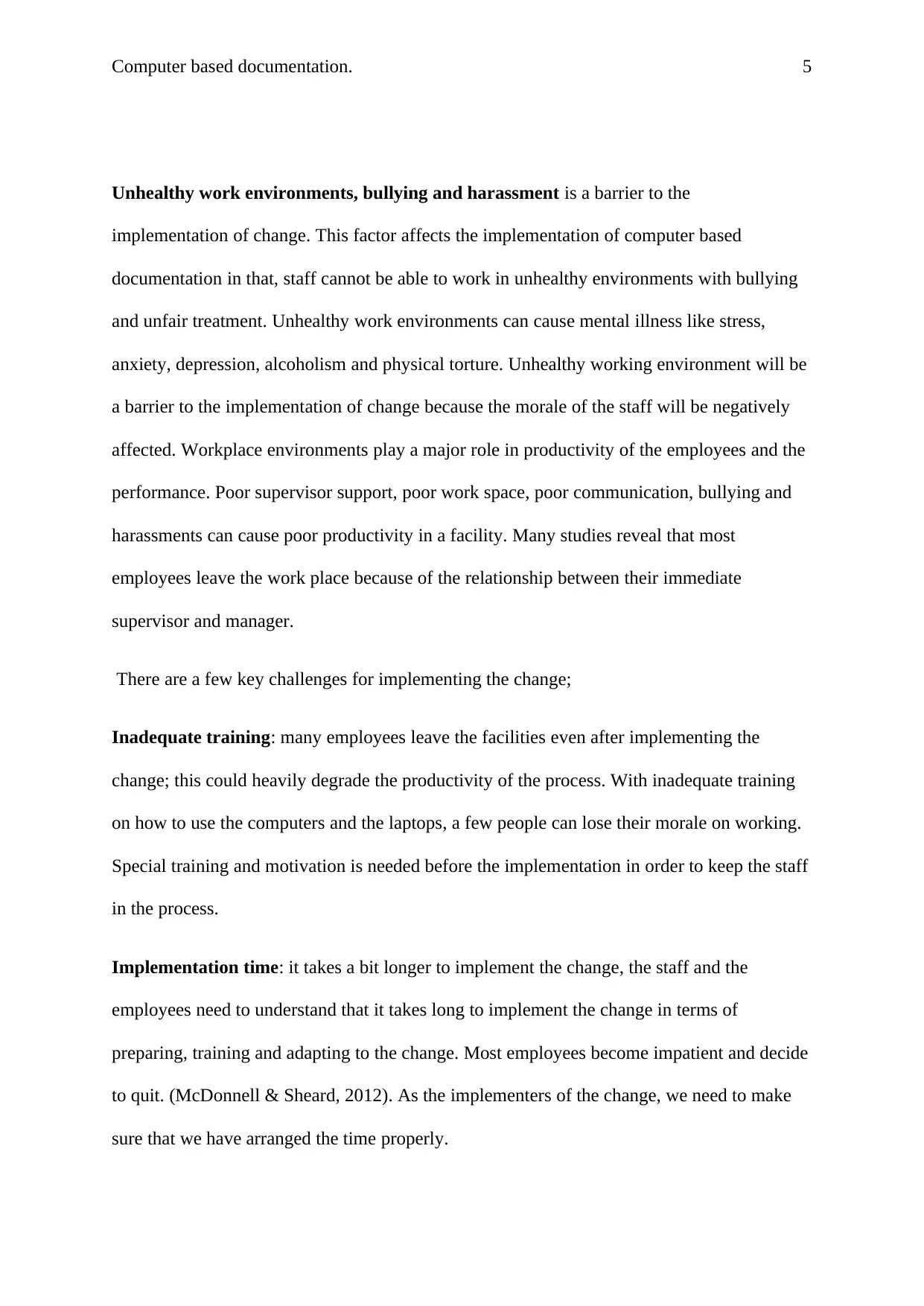
Computer based documentation. 5
Unhealthy work environments, bullying and harassment is a barrier to the
implementation of change. This factor affects the implementation of computer based
documentation in that, staff cannot be able to work in unhealthy environments with bullying
and unfair treatment. Unhealthy work environments can cause mental illness like stress,
anxiety, depression, alcoholism and physical torture. Unhealthy working environment will be
a barrier to the implementation of change because the morale of the staff will be negatively
affected. Workplace environments play a major role in productivity of the employees and the
performance. Poor supervisor support, poor work space, poor communication, bullying and
harassments can cause poor productivity in a facility. Many studies reveal that most
employees leave the work place because of the relationship between their immediate
supervisor and manager.
There are a few key challenges for implementing the change;
Inadequate training: many employees leave the facilities even after implementing the
change; this could heavily degrade the productivity of the process. With inadequate training
on how to use the computers and the laptops, a few people can lose their morale on working.
Special training and motivation is needed before the implementation in order to keep the staff
in the process.
Implementation time: it takes a bit longer to implement the change, the staff and the
employees need to understand that it takes long to implement the change in terms of
preparing, training and adapting to the change. Most employees become impatient and decide
to quit. (McDonnell & Sheard, 2012). As the implementers of the change, we need to make
sure that we have arranged the time properly.
Unhealthy work environments, bullying and harassment is a barrier to the
implementation of change. This factor affects the implementation of computer based
documentation in that, staff cannot be able to work in unhealthy environments with bullying
and unfair treatment. Unhealthy work environments can cause mental illness like stress,
anxiety, depression, alcoholism and physical torture. Unhealthy working environment will be
a barrier to the implementation of change because the morale of the staff will be negatively
affected. Workplace environments play a major role in productivity of the employees and the
performance. Poor supervisor support, poor work space, poor communication, bullying and
harassments can cause poor productivity in a facility. Many studies reveal that most
employees leave the work place because of the relationship between their immediate
supervisor and manager.
There are a few key challenges for implementing the change;
Inadequate training: many employees leave the facilities even after implementing the
change; this could heavily degrade the productivity of the process. With inadequate training
on how to use the computers and the laptops, a few people can lose their morale on working.
Special training and motivation is needed before the implementation in order to keep the staff
in the process.
Implementation time: it takes a bit longer to implement the change, the staff and the
employees need to understand that it takes long to implement the change in terms of
preparing, training and adapting to the change. Most employees become impatient and decide
to quit. (McDonnell & Sheard, 2012). As the implementers of the change, we need to make
sure that we have arranged the time properly.
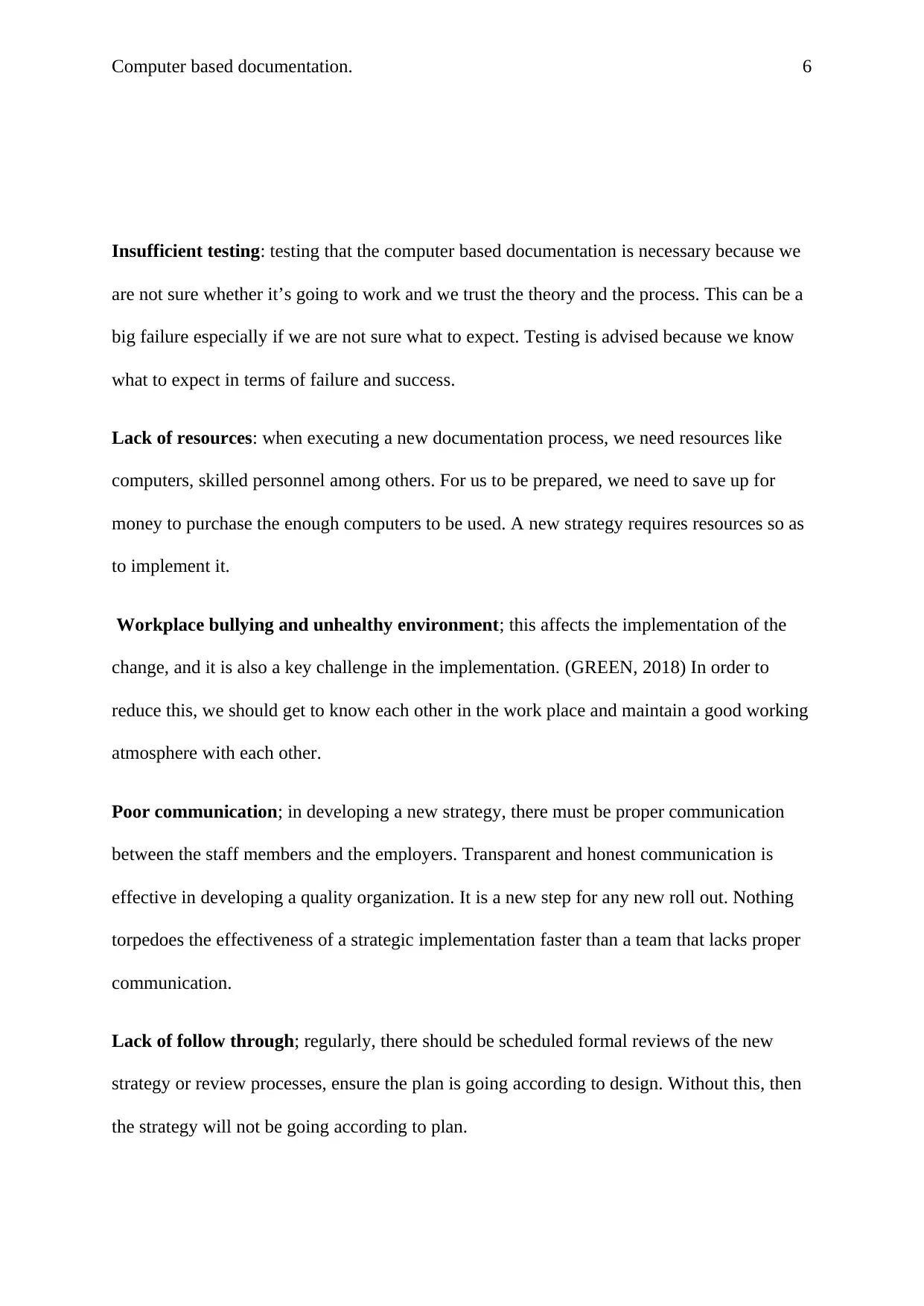
Computer based documentation. 6
Insufficient testing: testing that the computer based documentation is necessary because we
are not sure whether it’s going to work and we trust the theory and the process. This can be a
big failure especially if we are not sure what to expect. Testing is advised because we know
what to expect in terms of failure and success.
Lack of resources: when executing a new documentation process, we need resources like
computers, skilled personnel among others. For us to be prepared, we need to save up for
money to purchase the enough computers to be used. A new strategy requires resources so as
to implement it.
Workplace bullying and unhealthy environment; this affects the implementation of the
change, and it is also a key challenge in the implementation. (GREEN, 2018) In order to
reduce this, we should get to know each other in the work place and maintain a good working
atmosphere with each other.
Poor communication; in developing a new strategy, there must be proper communication
between the staff members and the employers. Transparent and honest communication is
effective in developing a quality organization. It is a new step for any new roll out. Nothing
torpedoes the effectiveness of a strategic implementation faster than a team that lacks proper
communication.
Lack of follow through; regularly, there should be scheduled formal reviews of the new
strategy or review processes, ensure the plan is going according to design. Without this, then
the strategy will not be going according to plan.
Insufficient testing: testing that the computer based documentation is necessary because we
are not sure whether it’s going to work and we trust the theory and the process. This can be a
big failure especially if we are not sure what to expect. Testing is advised because we know
what to expect in terms of failure and success.
Lack of resources: when executing a new documentation process, we need resources like
computers, skilled personnel among others. For us to be prepared, we need to save up for
money to purchase the enough computers to be used. A new strategy requires resources so as
to implement it.
Workplace bullying and unhealthy environment; this affects the implementation of the
change, and it is also a key challenge in the implementation. (GREEN, 2018) In order to
reduce this, we should get to know each other in the work place and maintain a good working
atmosphere with each other.
Poor communication; in developing a new strategy, there must be proper communication
between the staff members and the employers. Transparent and honest communication is
effective in developing a quality organization. It is a new step for any new roll out. Nothing
torpedoes the effectiveness of a strategic implementation faster than a team that lacks proper
communication.
Lack of follow through; regularly, there should be scheduled formal reviews of the new
strategy or review processes, ensure the plan is going according to design. Without this, then
the strategy will not be going according to plan.
⊘ This is a preview!⊘
Do you want full access?
Subscribe today to unlock all pages.

Trusted by 1+ million students worldwide
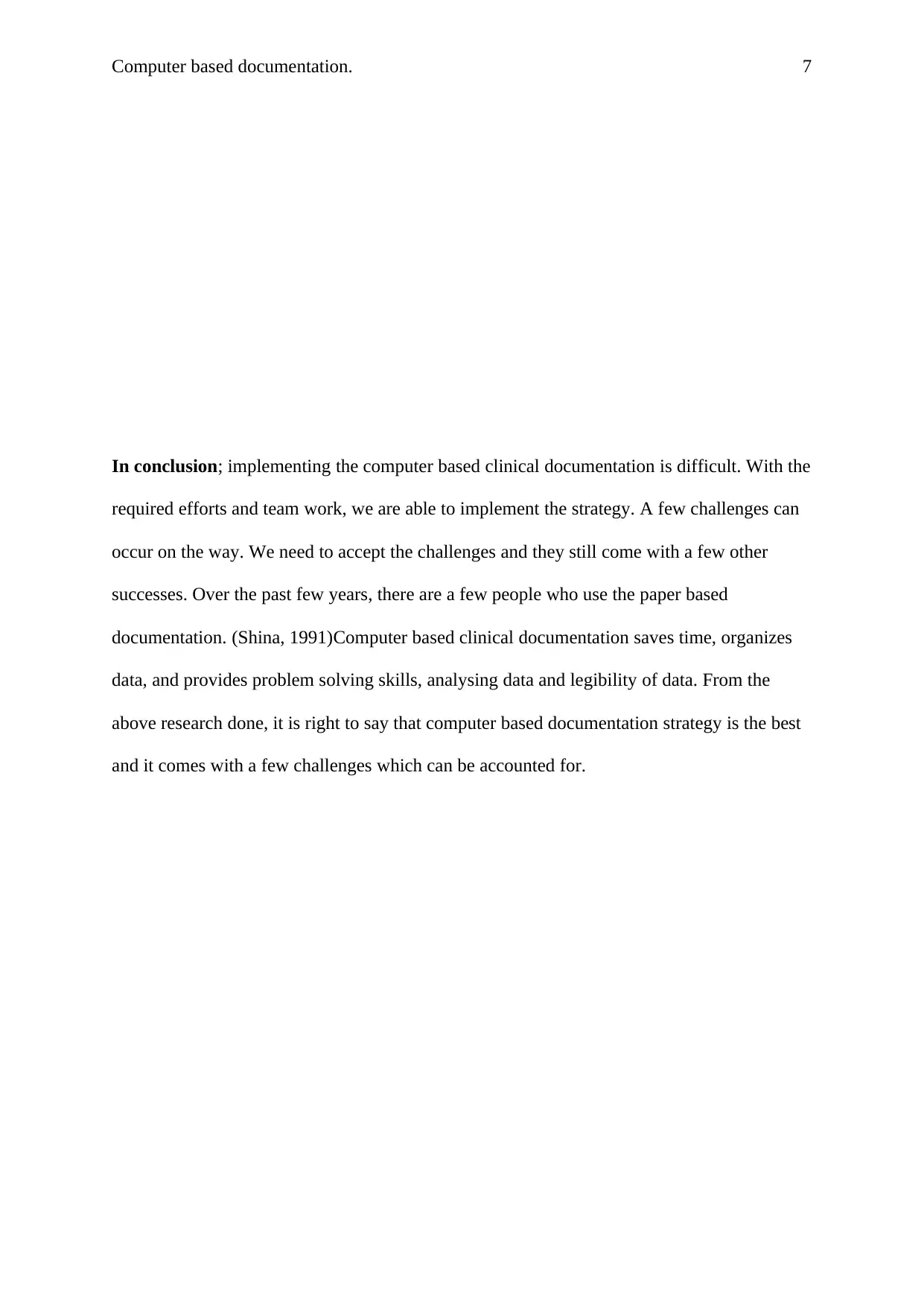
Computer based documentation. 7
In conclusion; implementing the computer based clinical documentation is difficult. With the
required efforts and team work, we are able to implement the strategy. A few challenges can
occur on the way. We need to accept the challenges and they still come with a few other
successes. Over the past few years, there are a few people who use the paper based
documentation. (Shina, 1991)Computer based clinical documentation saves time, organizes
data, and provides problem solving skills, analysing data and legibility of data. From the
above research done, it is right to say that computer based documentation strategy is the best
and it comes with a few challenges which can be accounted for.
In conclusion; implementing the computer based clinical documentation is difficult. With the
required efforts and team work, we are able to implement the strategy. A few challenges can
occur on the way. We need to accept the challenges and they still come with a few other
successes. Over the past few years, there are a few people who use the paper based
documentation. (Shina, 1991)Computer based clinical documentation saves time, organizes
data, and provides problem solving skills, analysing data and legibility of data. From the
above research done, it is right to say that computer based documentation strategy is the best
and it comes with a few challenges which can be accounted for.
Paraphrase This Document
Need a fresh take? Get an instant paraphrase of this document with our AI Paraphraser
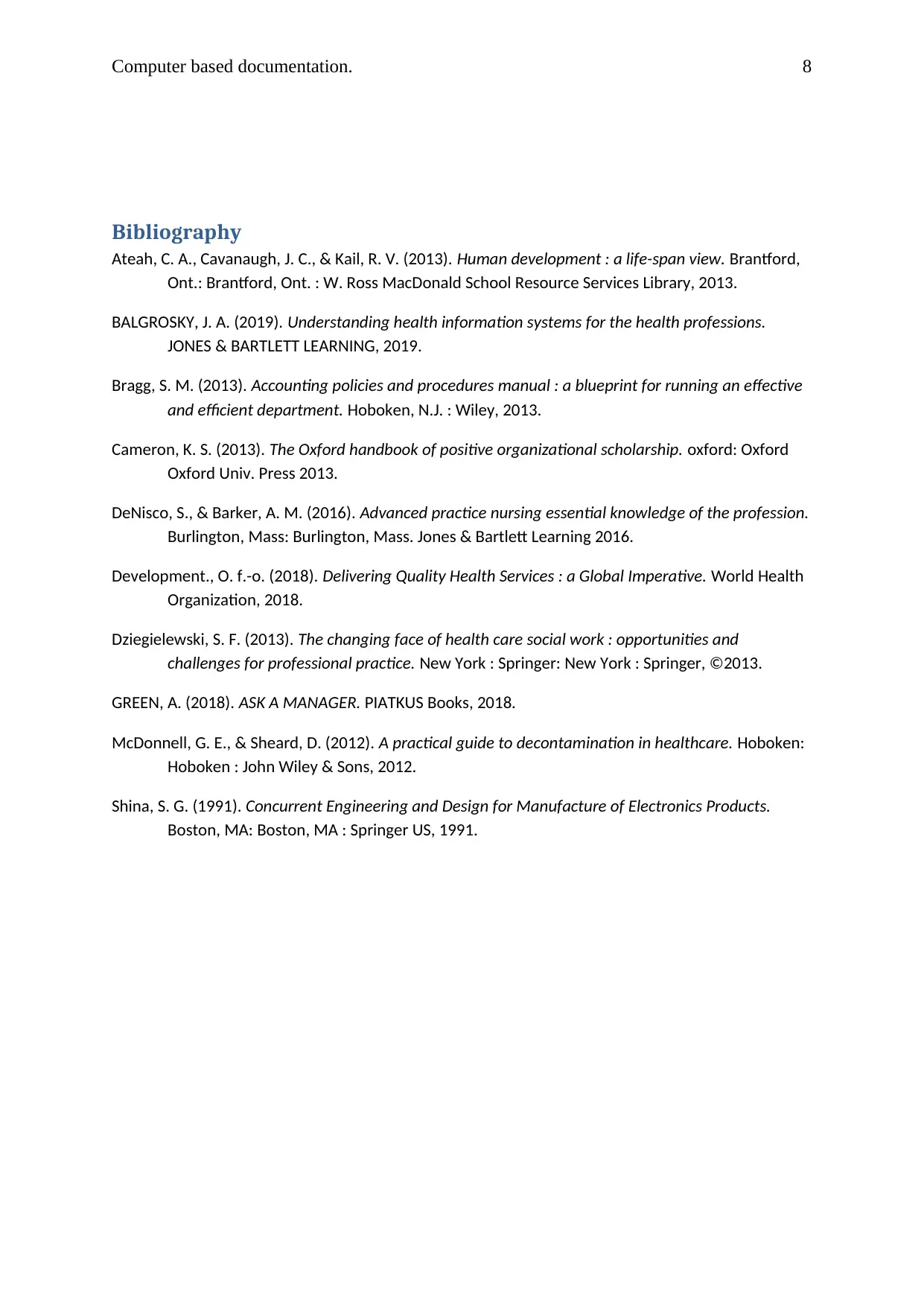
Computer based documentation. 8
Bibliography
Ateah, C. A., Cavanaugh, J. C., & Kail, R. V. (2013). Human development : a life-span view. Brantford,
Ont.: Brantford, Ont. : W. Ross MacDonald School Resource Services Library, 2013.
BALGROSKY, J. A. (2019). Understanding health information systems for the health professions.
JONES & BARTLETT LEARNING, 2019.
Bragg, S. M. (2013). Accounting policies and procedures manual : a blueprint for running an effective
and efficient department. Hoboken, N.J. : Wiley, 2013.
Cameron, K. S. (2013). The Oxford handbook of positive organizational scholarship. oxford: Oxford
Oxford Univ. Press 2013.
DeNisco, S., & Barker, A. M. (2016). Advanced practice nursing essential knowledge of the profession.
Burlington, Mass: Burlington, Mass. Jones & Bartlett Learning 2016.
Development., O. f.-o. (2018). Delivering Quality Health Services : a Global Imperative. World Health
Organization, 2018.
Dziegielewski, S. F. (2013). The changing face of health care social work : opportunities and
challenges for professional practice. New York : Springer: New York : Springer, ©2013.
GREEN, A. (2018). ASK A MANAGER. PIATKUS Books, 2018.
McDonnell, G. E., & Sheard, D. (2012). A practical guide to decontamination in healthcare. Hoboken:
Hoboken : John Wiley & Sons, 2012.
Shina, S. G. (1991). Concurrent Engineering and Design for Manufacture of Electronics Products.
Boston, MA: Boston, MA : Springer US, 1991.
Bibliography
Ateah, C. A., Cavanaugh, J. C., & Kail, R. V. (2013). Human development : a life-span view. Brantford,
Ont.: Brantford, Ont. : W. Ross MacDonald School Resource Services Library, 2013.
BALGROSKY, J. A. (2019). Understanding health information systems for the health professions.
JONES & BARTLETT LEARNING, 2019.
Bragg, S. M. (2013). Accounting policies and procedures manual : a blueprint for running an effective
and efficient department. Hoboken, N.J. : Wiley, 2013.
Cameron, K. S. (2013). The Oxford handbook of positive organizational scholarship. oxford: Oxford
Oxford Univ. Press 2013.
DeNisco, S., & Barker, A. M. (2016). Advanced practice nursing essential knowledge of the profession.
Burlington, Mass: Burlington, Mass. Jones & Bartlett Learning 2016.
Development., O. f.-o. (2018). Delivering Quality Health Services : a Global Imperative. World Health
Organization, 2018.
Dziegielewski, S. F. (2013). The changing face of health care social work : opportunities and
challenges for professional practice. New York : Springer: New York : Springer, ©2013.
GREEN, A. (2018). ASK A MANAGER. PIATKUS Books, 2018.
McDonnell, G. E., & Sheard, D. (2012). A practical guide to decontamination in healthcare. Hoboken:
Hoboken : John Wiley & Sons, 2012.
Shina, S. G. (1991). Concurrent Engineering and Design for Manufacture of Electronics Products.
Boston, MA: Boston, MA : Springer US, 1991.
1 out of 8
Related Documents
Your All-in-One AI-Powered Toolkit for Academic Success.
+13062052269
info@desklib.com
Available 24*7 on WhatsApp / Email
![[object Object]](/_next/static/media/star-bottom.7253800d.svg)
Unlock your academic potential
Copyright © 2020–2025 A2Z Services. All Rights Reserved. Developed and managed by ZUCOL.





